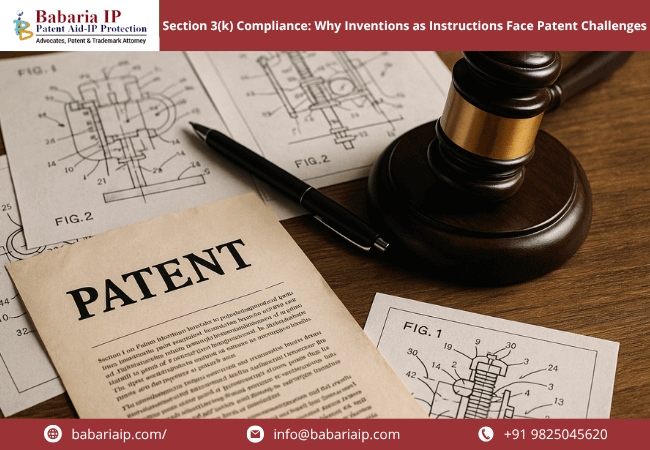Section 3(k) Compliance: Why Inventions as Instructions Face Patent Challenges

For inventors in the technology and innovation industries to secure their intellectual property, patent protection is essential. However, patenting inventions that mainly depend on directions, like software programs, algorithms, and business techniques, is made extremely difficult for the patent law firms in India under Section 3(k) of the Indian Patents Act, 1970. The complexities of Section 3(k), its effects on patent eligibility, and methods for overcoming its obstacles are all covered in detail in this article.
Section 3(k) of the Indian Patents Act
Section 3(k)3 clearly addresses the patentability of specific categories of creative inventions, especially those pertaining to abstract notions and information processing, within the larger framework of Section 3. “A mathematical or business method or a computer program per se or algorithms” are not considered innovations under the Act, according to this statement. The patentability of software-related innovations and business practices in India is significantly impacted by this clause.
The meaning of the term “computer program ” is especially important and has generated a lot of discussion and judicial examination. Inventions that use computer programs and exhibit a technical impact, implemented by a hardware device, are often regarded as patentable, even though computer programs themselves are disallowed. In a similar vein, algorithms, business procedures, and mathematical techniques are typically not included unless they are combined with a piece of hardware or a procedure that offers a noticeable technological breakthrough.
Since it has a direct impact on their patenting methods and the extent of intellectual property protection available for their innovations, it is critical for inventors and companies that work in technology-driven sectors in India to be familiar with the complexity of Section 3(k).
Important Points To Remember for Patent Protection Eligibility
Steps for Examining Computer-Related Inventions (CRI)
To bring its criteria for reviewing Computer Related Inventions (CRI) into line with international norms the Indian Patent Office (IPO) has taken a number of actions. The first guidelines for evaluating CRI were released by the India Patent Office (IPO) in August 2015. Later, in 2016 and 2017, the IPO made two revisions to the criteria. In addition to lacking advice for developing technologies, the currently in effect 2017 rules do not specify what a “technical effect” or “technical contribution” is for CRI. In order to provide further clarity on CRI inspection, the IPO published draft guidelines in April 2025 that included examples and current case laws, as well as a specific definition of the phrases “technical effect/technical contribution.”
Emerging technologies like artificial intelligence (AI), blockchain, machine learning, the internet of things (IoT), big data, and quantum computing are acknowledged as possible patentable invention areas in the rules that are being suggested.
Inventions excluded from section 3(k)
Below are the inventions excluded from section 3(k):
- Mathematical Techniques: Patents cannot be granted for pure mathematical theories or formulas.
- Business Methods: Even if they are used on a well-known computer system, business methods are not included.
- Computer programs in and of themselves: Patents cannot be granted for software that lacks a technological impact or hardware integration.
- Algorithms: Abstract algorithms are not included if they have no particular technical use.
Technical Effect Requirement
A computer-related invention must exhibit a “technical effect” or advance a “technical field” in order to qualify for patent protection. This implies that the invention must address a technological issue or advance technology beyond the simple automation of a business procedure.
Meeting Section 3(k) Requirements
To be patentable under Section 3(k), an invention involving a business method must demonstrate a specific, credible technical effect or enhancement beyond general computer functionality, not just improved system functionality, but a clearly defined, distinct, and innovative technical advantage.
- Detailed and specific claims: Draft claims that clearly define the technical aspects of the invention, avoiding abstract or generalised language.
- Emphasise technical contributions: Highlight how the invention solves a specific technical problem or contributes to a technical field.
- Combine software with hardware: Demonstrate how the software interacts with hardware components to achieve a technical effect.
- Focus on the inventive step: Ensure the invention involves an inventive step that is not obvious to someone skilled in the relevant technical field.
Conclusion
In the end, it’s critical to find a balance between encouraging software innovation and avoiding the monopolization of core algorithms and computational ideas. In order to demonstrate practical technological benefits, inventors must carefully explain to the patent attorney and support the technical contributions of their creations, going beyond simple computational reasoning.
In India’s rapidly changing technological landscape, innovators can improve their chances of obtaining patent protection by strategically navigating the requirements of Section 3(k) and concentrating on specific claims that highlight technological advancements and clearly demonstrate the inventive step within a technical context.
Fatal error: Uncaught TypeError: count(): Argument #1 ($value) must be of type Countable|array, bool given in /home/u719271378/domains/babariaip.com/public_html/blog/wp-content/themes/blog/template-parts/content-single.php:41 Stack trace: #0 /home/u719271378/domains/babariaip.com/public_html/blog/wp-includes/template.php(785): require() #1 /home/u719271378/domains/babariaip.com/public_html/blog/wp-includes/template.php(718): load_template() #2 /home/u719271378/domains/babariaip.com/public_html/blog/wp-includes/general-template.php(204): locate_template() #3 /home/u719271378/domains/babariaip.com/public_html/blog/wp-content/themes/blog/single.php(41): get_template_part() #4 /home/u719271378/domains/babariaip.com/public_html/blog/wp-includes/template-loader.php(106): include('/home/u71927137...') #5 /home/u719271378/domains/babariaip.com/public_html/blog/wp-blog-header.php(19): require_once('/home/u71927137...') #6 /home/u719271378/domains/babariaip.com/public_html/blog/index.php(17): require('/home/u71927137...') #7 {main} thrown in /home/u719271378/domains/babariaip.com/public_html/blog/wp-content/themes/blog/template-parts/content-single.php on line 41

